Huddersfield, West Yorkshire
Up to 1834
A parliamentary report of 1777 recorded local workhouses in operation at Huddersfield (with accommodation for 50 or 60 inmates), Aldmonbury (60), Kirkheaton (19), and Lockwood (15). There were early workhouses at Honley and Lepton, and by 1815 ones had been established at Golcar, Linthwaite, and Marsden. Wooldale and Thurstonland set up workhouses after 1815. By 1834, establishments also existed at Slaithwaite, Upperthong, Lindley, and possibly at Netherthong, Scholes, Holme, Dalton, and Longwood (Place, 2004).
The Huddersfield township workhouse was at Birkby, at the south side of Blacker Lane.
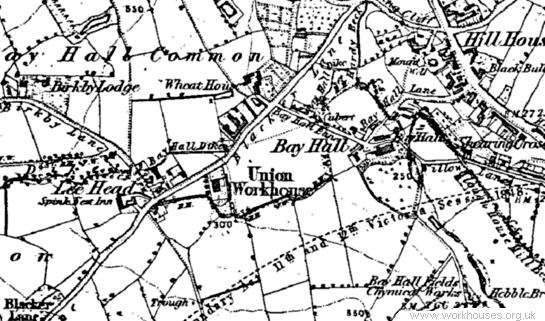
Huddersfield township workhouse site, 1851.
The rectangular building, presumably of more than one storey, was surrounded by cultivated grounds to the front and rear. A separate block to the south-east of the main building contained a washing (i.e. laundry) house and hospital.
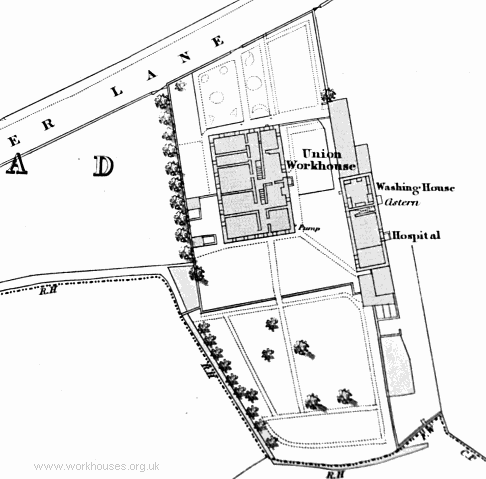
Huddersfield township workhouse site, 1851.
Almondbury's workhouse lay at the west of the township, at the junction of Kaye Lane and Wheatroyd Lane.
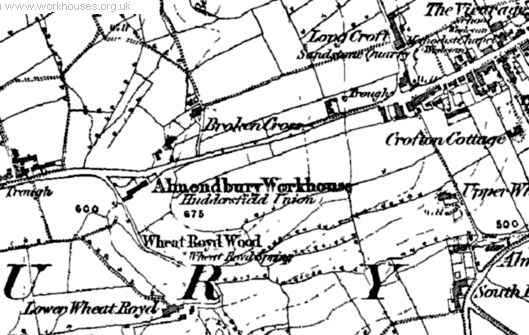
Almondbury township workhouse site, 1854.
The Golcar township workhouse was at Pike Law, to the south of Scapegoat Hill.
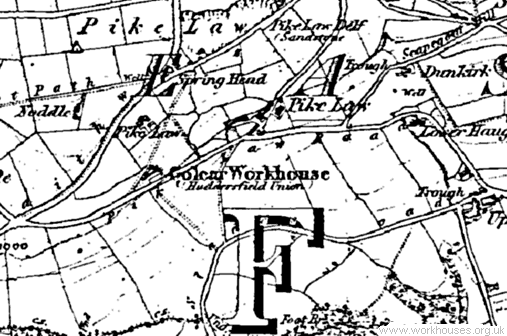
Golcar township workhouse site, 1854.
Honley had a workhouse from as early as 1703, thought to be located at Victoria Place in Thirstin. It was replaced in 1763 by a new workhouse erected nearby, on land that had donated by the Earl of Dartmouth. The new workhouse was also used by the Netherthong and South Crosland townships.
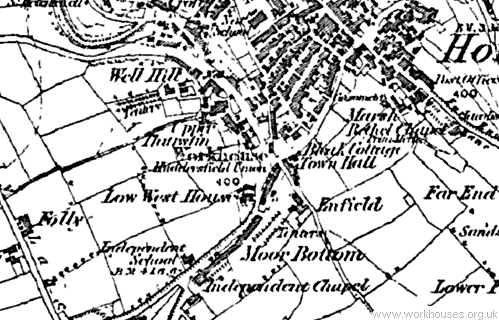
Honley township workhouse site, 1854.
Kirkheaton's workhouse stood at the west side of Workhouse Lane, now Moorside Road.
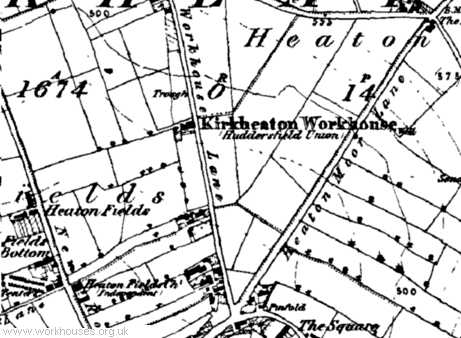
Kirkheaton township workhouse site, 1854.
Lepton had a workhouse from at least 1763. A Lepton workhouse stood to the south-east of Fenay Bridge, on what is now Fenay Bankside, off Station Road.
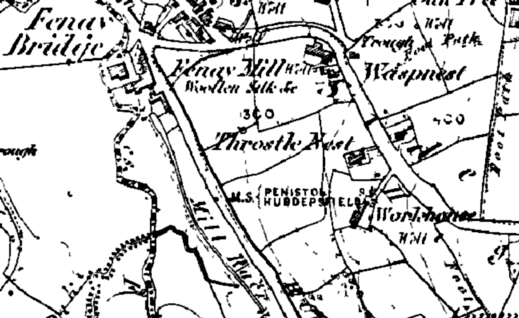
Lepton township workhouse site, 1854.
Lindley's workhouse stood to the north of what is now Moor Hill Road.
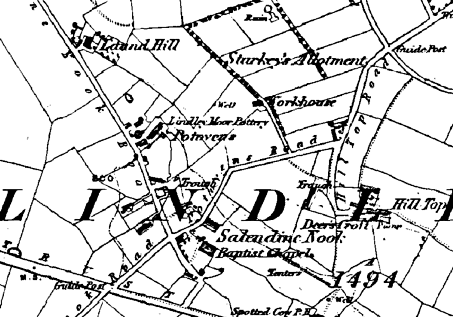
Lindley township workhouse site, 1854.
The Linthwaite workhouse was at the south side of what is now Causeway side.
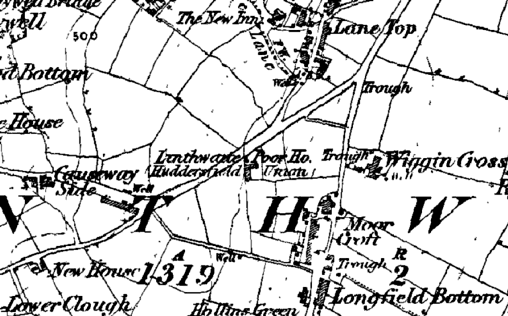
Linthwaite township workhouse site, 1854.
Lockwood, one of the largest townships in the Huddersfield area, erected a workhouse in 1761. It stood between Swan Lane (now Park Road) and Yew Green Lane. The site, originally rented from John Lister Kaye, is now occupied the David Brown engineering company.
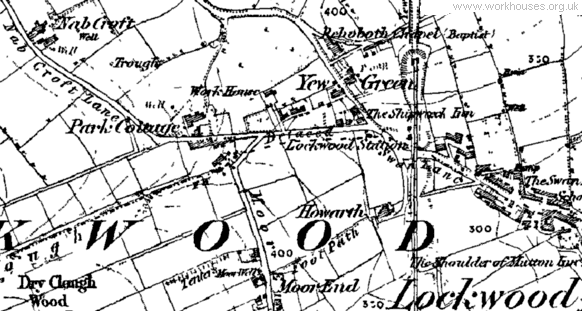
Lockwood township workhouse site, 1854.
Slaithwaite had a poorhouse located to the north of the township on Back o'Wall near Worts Hill. The house, still known as Poor House, is a rare survivor amongst Huddersfield workhouses.
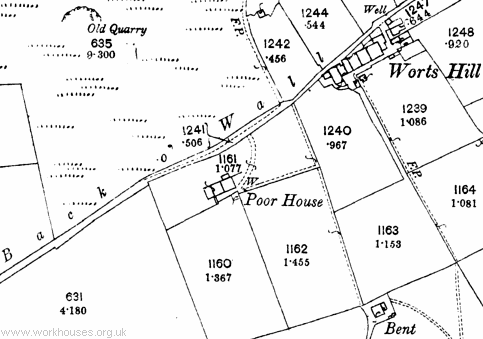
Slaithwaite township workhouse site, 1892.
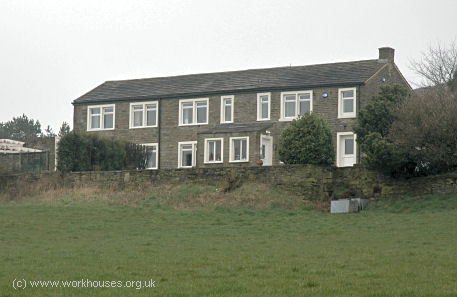
Huddersfield former Slaithwaite workhouse, 2006.
© Peter Higginbotham.
A building shown as "Workhouse - Huddersfield Union" is shown on the 1854 OS map at Liphill Bank, Upperthong. However, whether this building was used prior to 1834 is unclear from surviving records.
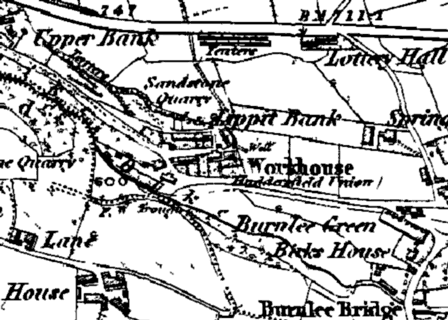
Upperthong workhouse site, 1854.
A workhouse or poorhouse stood on Brow lane, now Cemetery Road, at the south side of Holmfirth, near the boundary between Wooldale and Cartworth — both of which it probably served.
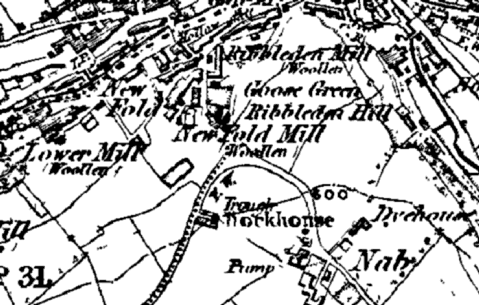
Wooldale township workhouse site, 1854.
After 1834
Huddersfield Poor Law Union formally came into being on 10th February 1837. Its operation was overseen by an elected Board of Guardians, 41 in number, representing its 34 constituent parishes and townships as listed below (figures in brackets indicate numbers of Guardians if more than one):
Yorkshire — West Riding:
Almondbury (2), Austonley, Cumberworth Half, Cumberworth Lower, Cartworth, South Crosland, Dalton, Farnley Tyas, Foolstone, Golcar, Hepworth, Holme, Honley (2), Huddersfield (5), Kirkburton, Kirkheaton, Lepton, Lingards, Linthwaite, Lockwood, Longwoods, Meltham, Marsden in Almondbury, Marsden in Huddersfield, Netherthong, Quarmby with Lindley, Scammonden, Shelley, Shepley, Slaithwaite, Thurstonland, Upperthong, Upper Whitley, Wooldale (2).
Later additions: Scholes (from 1894), Skelmanthorpe (from 1876).
The population falling within the Union at the 1831 census had been 88,772 — the largest of any union in Yorkshire, and one of the largest in the country. It member parishes and townships ranged in size from Holme (population 630) to Huddersfield itself (19,035).
Huddersfield, along with other industrial towns such as Dewsbury, Oldham, and Rochdale, was one of the main hotbeds of radical politics in the north and of resistance to the new poor law. In the previous few years, political activists in the area, such as Richard Oastler, had gained experience in organizing local campaigns, particularly in relation to improving conditions in factories through the "Ten Hour Bill".
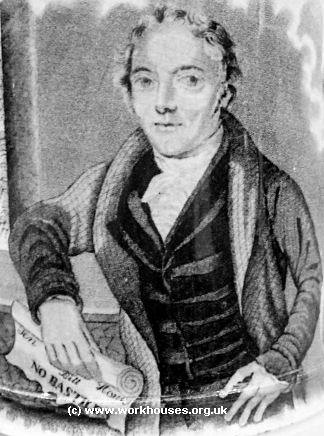
Richard Oastler.
© Peter Higginbotham.
The first Huddersfield Board of Guardians elected in 1837 had a majority of anti-New-Poor-Law members and refused to appoint a Clerk, without which the business of the Union could not be performed. Its early meetings were turbulent with and frequently disrupted by angry, and sometimes violent, crowds. The Poor Law Commissioners eventually threatened to dissolve the union and also applied pressure on local magistrates (who were automatically ex officio members of the Board). At the end of January 1838, a Clerk was finally appointed. However, resistance continued by other means.
The Huddersfield Board of Guardians took over all the existing township workhouses and decided to retain the five largest at Huddersfield, Almondbury, Kirkheaton, Golcar, and Honley, and to close the other smaller ones. This scheme provoked some opposition from the churchwardens and overseers in the townships where the smaller workhouses were located and some of these appear to have continued in operation.
Because of their distributed locations, the supervision of the township workhouses effectively became devolved to the Guardians in whose locality they stood. These were old buildings and in some cases little more than converted houses. Staff were often low-paid and poorly educated (nationally, a workhouse master could be paid as little as 10% of the salary of the governor of a similarly sized prison) and inspection was erratic.
The main check on the workhouse conditions was supposed to be through a Visiting Committee — a sub-committee of the Board of Guardians — who had a precise check-list of items they were supposed to inspect, but it seems likely that this did not take place, or not to any great effect. One of the main underlying aims of the 1834 was to reduce the cost of poor relief, which was paid for by local ratepayers in each Union — the people who elected the Guardians. Minimizing costs was primarily achieved by paying low wages, and economising on food and building maintenance. There were also incidents of workhouse officers embezzling supplies, lodging their relatives in the workhouse, and so on.
The Huddersfield Township Workhouse, Birkby
One particular problem area was the conditions for treatment of the sick at the Huddersfield township workhouse. Over a four-year period from about 1843, complaints about these were regularly made by Thomas Tatham, medical officer for the northern division of the Union. Eventually, in 1848, the Huddersfield Overseers conducted an enquiry and held a public meeting where their report was presented:
The overseers... are forced to the conclusion that the sick poor have been most shamefully neglected; that they have been and still are devoid of the necessary articles of clothing and bedding; that they have been suffered to remain for weeks at a time in the most filthy and disgusting state ; that patients have been allowed to remain for nine weeks together without a change of linen or of bed clothing: that beds in which patients suffering in typhus have died, one after another, have been again and again and repeatedly used for fresh patients, without any change or attempt at purification; that the said beds were only bags of straw and shavings, for the most part laid on the floor, and that the whole swarmed with lice; that two patients suffering in infectious fever, were almost constantly put together in one bed, that it not unfrequently happened that one would be ragingly delirious, when the other was dying; and that it is a fact that a living patient has occupied the same bed with a corpse for a considerable period after death; that the patients have been for months together without properly appointed nurses to attend to them; that there has been for a considerable time none but male paupers to attend on female patients; that when the poor sick creatures were laid in the most abject and helpless state—so debilitated as to pass their dejections as they lay, they have been suffered to remain in the most befouled state possible, besmeared in their own excrement, for days together and not even washed; that the necessary stimulants ordered by the medical officer have been withheld; that when patients' lives even depended on the free administration of wine, the fever hospital has been left without for more than forty-eight hours at a time; that death occurred amongst the patients from which such stimulant was withheld, which the medical officer attributes to this very cause; that the party whose duty it was to have provided such wine, was repeatedly applied to for it by the nurses at the hospital and the medical officer.
The report caused a scandal and received wide publicity in the press. A second report was equally damning about conditions in the workhouse as a whole.
Despite the outcry that the report produced, problems appear to have persisted. In 1857, a special commission found that lack of classification at Huddersfield resulted in 'abandoned women' with diseases of a 'most loathsome character' being mixed together with idiots, young children, and lying-in cases.
A report by Poor Law Board Inspector RB Cane after a visit to Birkby workhouse in October 1866 recorded that it was being used for the sick and for aged and infirm men and women, but was "wholly inadequate for their proper care". Its 110 inmates at that time comprised:
| Able-bodied men | 8 |
| Old and infirm men | 56 |
| Boys from 9 to 16 years | 1 |
| Able-bodied women | 16 |
| Old and infirm women | 22 |
| Girls from 9 to 16 years | 1 |
| Girls from 2 to 9 | 1 |
| Infants under 2 years | 5 |
| TOTAL | 110 |
The detached hospital block was described as "wholly unfit for the purpose, and quite devoid of comfort and convenience" and the medical officer considered that the building was quite insufficient for the purposes for which it was used. Some of the aged men slept together in the same bed, and all the beds were much too close crowded together. The day rooms were much too small and very seriously crowded. There was no classification beyond an imperfect separation of the sexes. The men and the women complained of the violent conduct of two insane or idiotic inmates, one in each, ward.
After the subsequent opening of the new workhouses at Deanhouse (1862) and Crosland Moor (1872), the old Huddersfield town workhouse became an infectious diseases hospital known as Birkby Hospital. The hospital closed in the early 1900s and was replaced by a school.
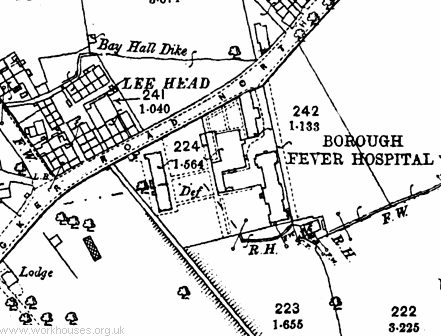
Birkby Hospital site, 1893.
Almondbury Workhouse
The Almondbury continued in operation until the new Deanhouse workhouse opened in 1862.
Golcar Workhouse
The Golcar workhouse was a small establishment sited in a bleak hillside location. In October 1866, Poor Law Board Inspector RB Cane noted that the premises were designated for able-bodied inmates, of whom 22 could be accommodated. He found the workhouse "wholly inadequate in every respect". It consisted of two old cottages, one for men and one for women, but with no yards. The men slept two to a same bed, with up to 14 in one small room containing seven beds. At the time of his visit, seven women and five children occupied four beds in one small room which also served as the lying-in ward. The kitchen and washhouse were a small lean-to shed and the inmates' "puddings" were boiled in the same copper as the foul linen was boiled and washed.
The workhouse was closed in around 1869 and housing now occupies the site.
Honley Workhouse
In July 1840, the Huddersfield Guardians recommended the transfer of women and children from the old Wooldale workhouse to Honley. Despite coming under repeated threat of closure, Honley stayed in operation until October 1862 when its inmates were transferred to the newly opened union workhouse at Deanhouse.
A local library now occupies the former workhouse site at the junction of West Avenue and Thirstin.
Kirkheaton Workhouse
Kirkheaton workhouse was described in an October 1866 inspection as "an old dilapidated building with none of the requisites of a workhouse. Ventilation, in the proper sense, does not exist." It could accommodate 50 inmates, and at this date its residents comprised 2 men, 16 boys, 6 women, 21 girls, and 2 infants.
The 16 boys and 2 men occupied eight beds in two small rooms. The women, girls and infants, 29 in number, occupied 13 beds in another part of the house. Two of the elder girls, affected by "incontinence of urine", slept together in the same bed. Three of the boys in the habit of "wetting the beds" slept together in the same bed which was in an abominable condition — the urine had not only saturated the bedding and the boards beneath the bed, but had found its way through the floor into the room below. The copper in which the foul linen is-boiled is used also for cooking the food of the inmates.
Earlier in the same year, the workhouse school had been visited by an an inspector of schools who recorded:
Plans for a New Workhouse
Despite the prevailing view amongst the Huddersfield Guardians that construction of a large, central, purpose-built workhouse was neither necessary nor desirable, pressure from the central Poor Law Commissioners resulted in periodic reconsideration of the issue. In February 1849, a committee appointed by the Guardians reported that the five existing workhouses, which were all rented by the union from their respective townships, could accommodate a total of 224 inmates at an annual cost of £420 in salaries, rent, and running costs. All the buildings were cramped and badly ventilated with a resulting increased risk of epidemics occurring. Inadequate classification and segregation also meant a lack of effective control and supervision. The report concluded that a single workhouse accommodating 225 inmates would be more economical. Despite these finding, no action was taken by the Board of Guardians.
In 1857, in response to a letter from the Poor Law Board about excessive numbers of inmates in the workhouses, another committee was set up by the Board of Guardians to investigate the situation. Its report suggested enlargements to the Huddersfield, Almondbury, Kirkheaton and Golcar workhouses to increase their total capacity from 241 to 575 at a cost of £4,440. Honley was considered impractical to improve. Again no action was taken, with the Board considering that such expenditure was "not expedient". However, one dissenting Board member, the Revd. R. Crowe, began an energetic campaign to reverse the decision. He catalogued the numerous faults in the existing workhouses — at Huddersfield, Golcar and Honley, male and female inmates could associate freely, even at night; impressionable children were allowed to mix with adult inmates of all character; many of the buildings were of defective structure or in poor condition.
Finally, in November 1857, the Guardians finally resolved to build a new workhouse in the Holmfirth district to replace the Almondbury, Honley and Golcar workhouses, plus improvements to the Huddersfield and Kirkheaton workhouses. Approval was given by the Poor Law Board for construction of a building to accommodate up to 600 inmates and costing no more than £10,000. Newspaper advertisements for suitable sites were placed in January 1858. Proceedings moved slowly, with a number of sites being considered. Eventually, early in 1860, a site at Deanhouse near Netherthong was purchased for £1,250.
Deanhouse Workhouse
The Deanhouse workhouse was ready to receive its first inmates in September 1862. It could accommodate 172. The building was designed by John Kirk and had a two-storey T-shaped main block at the south of the site. Shortly after its opening a vagrant ward for 10 men and 10 women was added. The workhouse location and layout are shown on the 1904 map below:
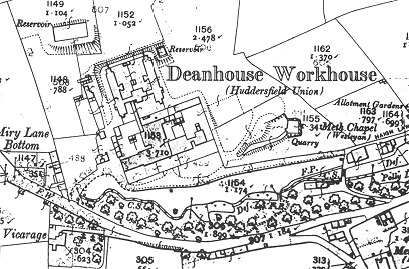
Huddersfield Deanhouse workhouse site, 1904.
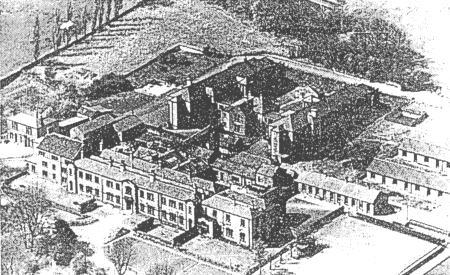
Huddersfield Deanhouse from the south-east.
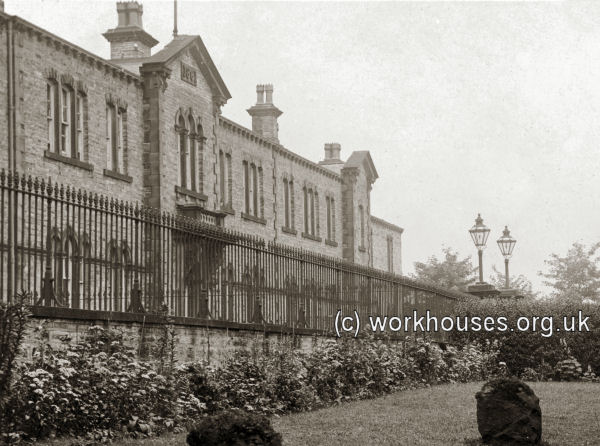
Huddersfield Deanhouse from the south-west, c.1905
In October 1866, Poor Law Inspector RB Cane visited what he referred to as the "Honley" workhouse, though this was clearly the new Deanhouse establishment. He expressed regret that "...so ill-arranged and incomplete a building was ever erected" with many parts of the building having been converted to uses for which they were never intended. For example, the vagrant wards had been converted into men's sick wards, the female receiving ward had been made into a bath room for female idiots, and the male receiving ward was used as an infirm ward. The children, 24 in number, had no day rooms. The boys associates with the adult male paupers and the girls with the able-bodied women, with no separation at night. All the waterclosets were constructed such that the foul air was drawn inwards and into the main body of the house. The sick wards were small square rooms with only three or four beds in each. The fireplace and the doors took up so much space that the beds could be properly separated and arranged.
In 1880, an infirmary was added at the north of the workhouse. It had a central administration block linked by covered walkways to male and female double pavilions at either side.
In 1938, the former workhouse, now a Public Assistance Institution, was taken over by the Upper Agbrigg Guardians' Area.
The workhouse buildings have now been demolished and the site redeveloped for housing.
Crosland Moor Workhouse
The capacity of the new Deanhouse workhouse soon proved inadequate and in 1866 the Guardians began to look for a site for further large workhouse. It was initially hoped to expand the existing Huddersfield workhouse site at Birkby but difficulties arose because the land involved was owned by a trust set up for the benefit of the poor who were not receiving parish relief. Following the consideration of a number of possibilities, a 15-acre site at Crosland Moor was finally acquired in January 1869. The foundation stone of the new workhouse was laid in July 1869 by the Chairman of the Guardians.
The Crosland Moor workhouse, also designed by John Kirk, was located at the south side of Barton Road (now Blackmoorfoot Road) at the south-west of Huddersfield. Its opening, on Friday 9th August 1872, was reported as follows:
OPENING OF THE CROSLAND MOOR WORKHOUSE, HUDDERSFIELD.
THE completion of the workhouse at
Crosland Moor has been celebrated by a luncheon, to which the guardians and
other gentlemen were invited. There are a few finishing strokes to give to the
building, and all the rooms are not yet furnished.
The buildings have been erected at a cost of 24,000l., on an eminence which
commands a fine view of beautiful scenery, and the situation is healthy and
salubrious. The principal entrance is on the north side, abutting the highway.
The road is 20 ft. wide, and on either side, to the extent of 150 yards, as far
as the lodge gates, trees are to be planted, and thus the institution will be
approached by an avenue. The facade of the building faces due east, and the
premises are so situated and designed as to admit of the entrance, in every
quarter, of the sun's beams.
The building is erected of stone,
procured from quarries in the locality, in the Domestic Gothic style of
architecture, from designs prepared by Messrs. John Kirk & Sons, of
Huddersfield and Dewsbury.
The centre building is 216 ft. long
and 52 ft. broad, and three stories high, arranged as follows, viz.:-In the
centre is the principal entrance and staircase, and branching right and left is
a corridor, 8 ft. wide on each floor, which will be used for easy access to all
the rooms, and for ventilation. In the centre tower is placed a large tank,
containing 10,000 gallons of water, to supply all the closets, lavatories,
baths, &c. Provision is also made to attach a plug and hose on each landing
in case of fire.
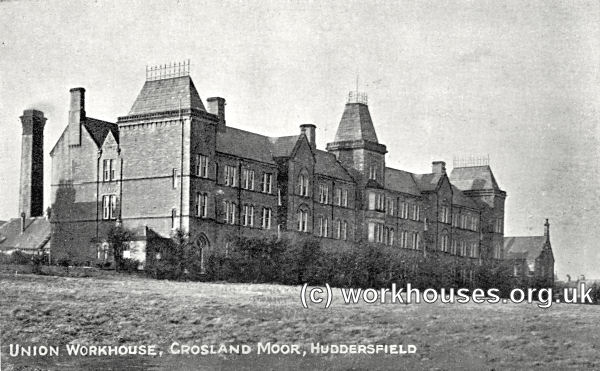
Crosland Moor main block from the east, early 1900s.
© Peter Higginbotham.
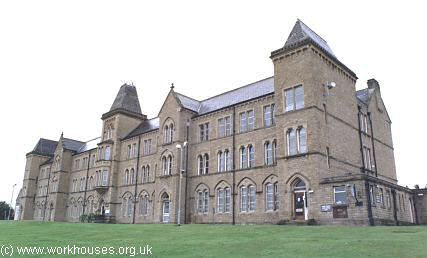
Crosland Moor main block from the north, 2001.
© Peter Higginbotham.
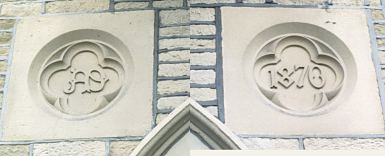
Main block entrance spandrels, 2001.
© Peter Higginbotham.
On the right of the principal entrance, on the ground floor, is the governor's office ; on the left, the matron's room. Over the same is the visiting committee's room, the governor's private rooms, and bedrooms. On each side of the staircase is a room set apart for clothing-stores ; also one room on each floor above for sundry stores. The remaining part of this building, on the right hand, is divided into six day-rooms for the men ; with four staircases to the dormitories, and doors into airing-grounds; and, to the left, into six day-rooms for the women, also with four stair-cases to the dormitories, and doors into the airing. grounds; making accommodation for 218 inmates. Behind this building, in the centre, with a direct road from the corridor under the principal stair-case, is the dining-hall, 58 ft. long by 35 ft. wide, with an open timber roof, and fitted up with desks and seats, and a reading-desk, and will seat 320. To the left of the dining-hall is the paid servants' sitting-room, kitchen, scullery, and a large cooking kitchen, fitted up with a steam apparatus ; also the bread-stores and general stores. The larders are under the bread-stores and general stores, and arched over.
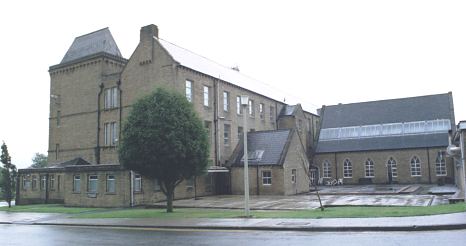
Dining-hall/chapel from the north-east, 2001.
© Peter Higginbotham.
The bakehouse, coals, and out-offices for the
servants, with a closed yard, are all conveniently arranged : to the right of
this is the refractory ward, and a large coal-store covered over with a slated
roof ; and to the left is the wash-house, drying-room, and laundry. The
boiler-house is so placed as to be convenient both for cooking-kitchen and
wash-house.
To the right of the main building is the hospital,
a two-storied building, 131 ft. long, one half for males, and one half for
females, each with separate entrances, staircases, and airing-grounds, and is
divided into ten sick-rooms, two convalescent day-rooms, surgery, kitchen,
scullery, and nurses' rooms, bath-rooms, and store. rooms. All the sick rooms
are so arranged as to be well ventilated, having windows on three sides, all
well supplied with water-closets, lavatories, with hot and cold water ; and
will accommodate 32 males and 43 females. The airing grounds are large and
open, being to the front, and will have a low wall and palisading. A little
beyond this is the building for fever and infectious diseases, with similar
arrangements to the large hospital, and will accommodate 10 males and 10
females.
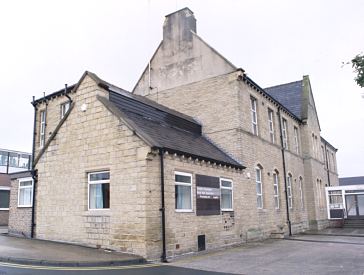
Crosland Moor infectious block from the south-east, 2001.
© Peter Higginbotham.
To the left of the main building is the school, 140 ft. long, consisting of two day-rooms, two school-rooms, two class-rooms, and sitting-rooms for the teachers. The schools and class-rooms are fitted up with galleries. At the back are covered sheds, for the children to play under in bad weather. The dormitories are on the first floor. There are large playgrounds, with wall and palisading.
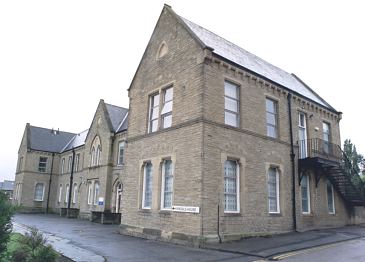
Huddersfield school block from the north, 2001.
© Peter Higginbotham.
The total number provided for is as
follows: Main building, 218; hospital, 75; infectious ward, 20; children,
100,—total, 413.
At the entrance is the porter's lodge, a two-storied building, with a weighing-machine. Attached behind the lodge are the receiving-wards for each sex, with day and night rooms, fitted up with bath-rooms. Near to the porter's lodge is the vagrant ward, the entrance being from Nab Croft-lane, and is so arranged in separate yards and day and night rooms that thirty males and fifteen females can have a night's lodging at the same time, each ward having bath-rooms, &c. Work-rooms are also provided.
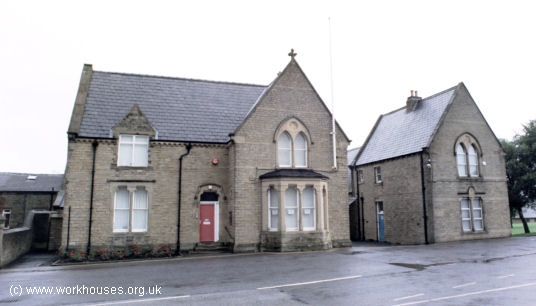
Huddersfield porter's lodge and receiving wards from the west, 2001.
© Peter Higginbotham.
The architects have confined the expenditure within the
estimates. The contractors were: Masons, Messrs. A. Graham & Sons; joiners,
Messrs. W. Fawcett & Sons ; plasterers, Messrs. T. Longbottom & Sons ;
plumber, Mr. H. Garton ; painter, Mr. G. Brighouse; Platers, Messrs. W. Goodwin
& Sons ; and ironfounders, Messrs. T. A. Heaps & Co.
Mr. Kirk, in responding, at the luncheon, to the toast of "The Architects,"
said the entire measurement of the workhouse was 8,243 yards. The cost of
erection was 2l. 15s. per yard, but it would be 3l. if they took in the
boundary-walls and palisading. They could not build a cottage house for a less
price than 2l. 10s. per yard, so that they had given the guardians a
very cheap building. If they took the number of inmates at 450, 55l. per
head would cover the whole cost.
The site location and layout are shown on the 1904 map below:
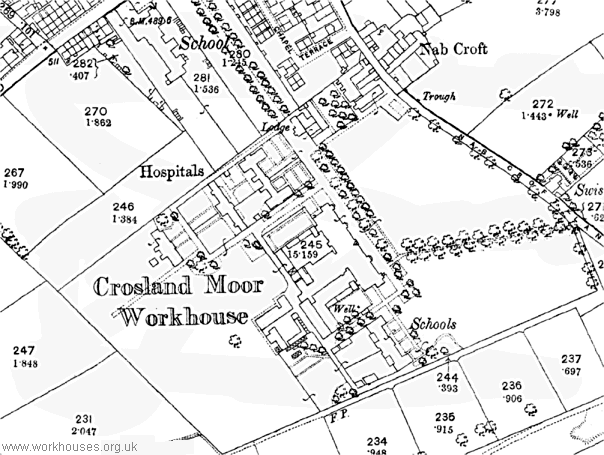
Huddersfield Crosland Moor workhouse site, 1890.
Following the opening of the Crosland Moor workhouse, the Deanhouse site was mainly used to house the very aged, lunatics and hospital patients.
The Crosland Moor workhouse later became St Luke's Hospital. Services at the site have been gradually run down prior to the hospital's closure.
Children's Homes
By the early 1900s, the Huddersfield Union set up children's scattered homes at 18 South Street Huddersfield and at New Hey Road, Outlane.
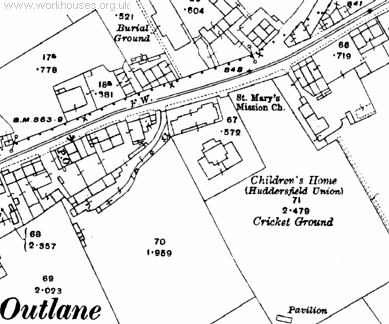
Outlane children's home site, 1918.
The former Outland children's home is now a hotel.
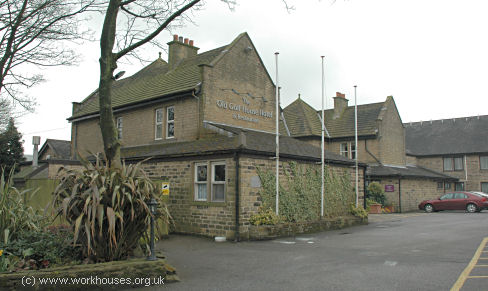
Huddersfield Outlane children's home from the north-east, 2006.
© Peter Higginbotham.
By 1924, further homes had been opened at 24 and 32 Ramsden Street, Huddersfield. A Receiving Home was established at Back Ramsden Street.
In around 1925, a children's cottage homes development was opened at 'The Leas', Scholes, near Holmfirth. The original mansion house on the site (known to the children as 'The Hall') was built in around 1870 and became the homes' administrative and communal facilities. Six children's cottages were erected in the grounds and were named Oak Cottage, Elm Cottage, Holly Cottage, Hawthorn Cottage, Chestnut Cottage, and Maple Cottage. An entrance lodge, now demolished, was located along side the site entrance on Park Side.
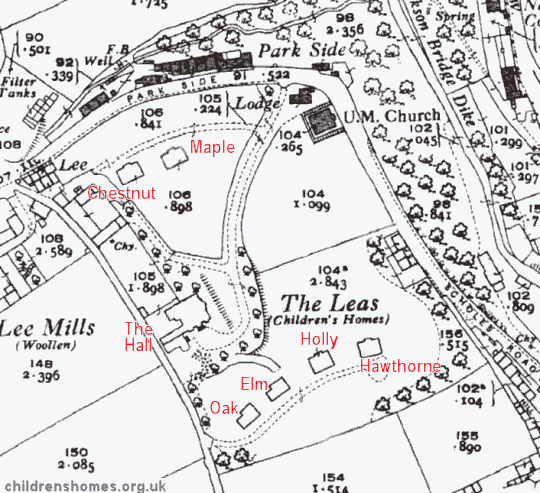
Scholes cottage homes site, c.1932.
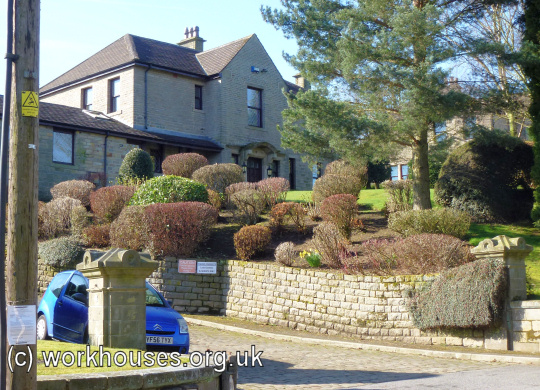
Scholes cottage homes site entrance and Maple Cottage from the north, 2015.
© Peter Higginbotham.
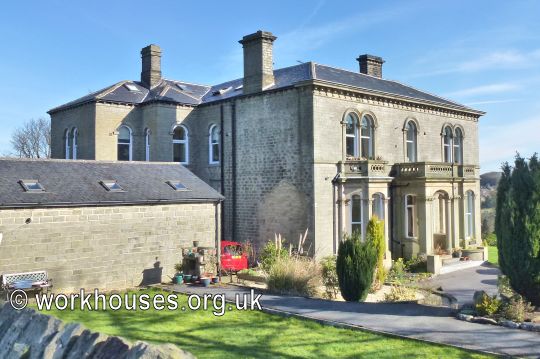
Scholes cottage homes The Hall from the south-west, 2015.
© Peter Higginbotham.
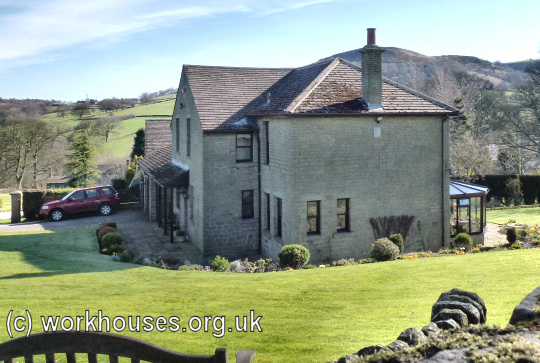
Scholes cottage homes Oak Cottage from the north, 2015.
© Peter Higginbotham.
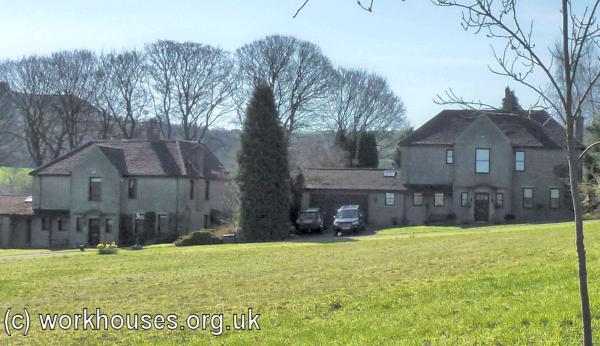
Scholes cottage homes Holly and Hawthorne Cottages from the north, 2015.
© Peter Higginbotham.
After 1930, the West Riding County Council took control of the homes, which in turn passed to Kirklees Council. The homes were closed in 1983 and the site stood empty for four years. It was then sold to developers with The Hall being divided into four properties and four new houses erected in a matching style to the original 'cottages'.
Staff
Inmates
- Long-term workhouse inmates (1861)
- Almondbury 1861 Census
- Crosland Moor 1881 Census
- Deanhouse 1881 Census
Records
Note: many repositories impose a closure period of up to 100 years for records identifying individuals. Before travelling a long distance, always check that the records you want to consult will be available.
- West Yorkshire Archive Service (Kirklees Office), Central Library, Princess Alexandra Walk, Huddersfield HD1 2SU. Surviving records include: Guardians' minute books (1837-1930), Printed lists of persons relieved (1875-1913).
- Huddersfield Local Studies Library, Princess Alexandra Walk, Huddersfield, West Yorkshire HD1 2SU. Holdings: Various accounts, List of Guardians (1879), Guardians handbook (1895).
Bibliography
- Chadwick, Anthony (1996) Huddersfield Workhouse. Ripon Museum Trust leaflet.
- Driver, F (1993) Power and Pauperism: The Workhouse System, 1834-1884. Cambridge University Press.
- Place, Allan (2004) Pray Remember the Poor. The Poor Laws and Huddersfield Holmfirth: Holme Valley Civic Society.
Links
- None.
Unless otherwise indicated, this page () is copyright Peter Higginbotham. Contents may not be reproduced without permission.


